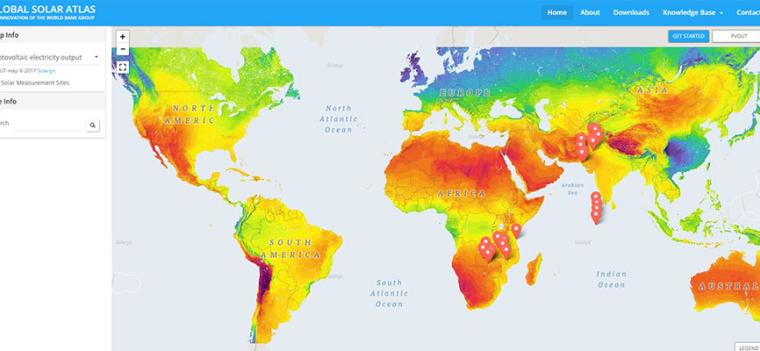News
- Responding to client’s needs, ESMAP and its partners have created a free, web-based tool—the Global Solar Atlas—that can help identify potential sites for solar power generation virtually anywhere in the world.
- The tool capitalizes on the advancement in methodologies and data quality over the past five years, allowing all countries to get initial solar maps, as opposed to commissioning these maps country-by-country as in the past.
- The tool creates a uniform platform for governments, investors, and developers to compare resource potential between sites in one region or across multiple countries.
The World Bank, in partnership with the International Solar Alliance (ISA), launched the Global Solar Atlas at the World Future Energy Summit in Abu Dhabi. It serves as an example of the World Bank’s commitment to ISA and to scaling up renewable energy in client countries.
This free, web-based tool will help investors and policymakers identify potential sites for solar power generation virtually anywhere in the world, at the click of a button. The tool displays annual average solar power potential, provides access to high resolution global and regional maps, and geographic information system (GIS) data. The underlying solar resource database is based on up to 22 years of satellite data, and has been validated using high quality ground-based measurement data where this exists. The data can also be accessed through the International Renewable Energy Agency’s (IRENA) Global Atlas for Renewable Energy, allowing users to overlay additional data such as transmission lines and protected areas to identify possible zones or sites for solar development.
Methodologies and data quality have advanced significantly over the last decade. The Global Solar Atlas capitalizes on this and makes the latest resource data available for free, in support of strategic planning and preliminary site assessments. This will help governments save millions of dollars on their own research and provide investors and solar developers with an easily accessible and uniform platform to compare resource potential between sites in one region or across multiple countries.
The Global Solar Atlas was funded by the Energy Sector Management Assistance Program (ESMAP) and commissioned in collaboration with the International Finance Corporation (IFC) to ensure relevance to both public and private sector stakeholders. It was developed by Solargis, a leading commercial provider of solar resource data.
“The World Bank is seeing a surge of interest from our clients in solar power as a result of the dramatic cost decreases over the past few years. We hope that the Global Solar Atlas will help inform the crucial planning and investment decisions that will need to be taken over the next decade to shift to more sustainable forms of energy,” said Riccardo Puliti, Senior Director and Head of the World Bank’s Energy & Extractives Global Practice.
While the data powering the Global Solar Atlas is the most recent and most accurate currently available, it is not fully validated in many developing countries due to the lack of ground-based measurement data from high precision solar radiation sensors. To reduce the risks associated with higher margins of uncertainty, the World Bank, with funding from ESMAP, intends to install solar measurement stations in at least 20 developing countries over the next four years. All data will be made publicly available, and is currently being published via the Energydata.info platform.
ESMAP is also funding the development of a Global Wind Atlas, a tool similar to the Global Solar Atlas that will map data for wind potential globally. This work will be taken forward over 2017.
Learn more about the ESMAP Renewable Energy Program
